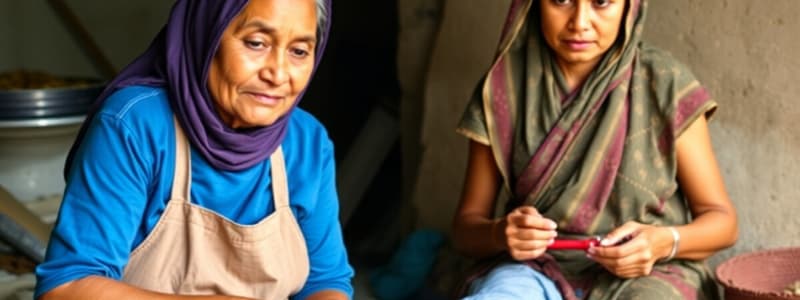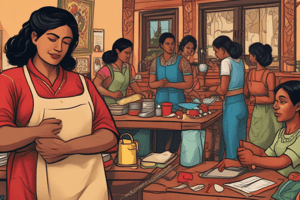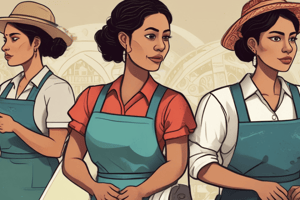Podcast
Questions and Answers
What is the main argument put forth by Duncombe and Marsden regarding equality within households?
What is the main argument put forth by Duncombe and Marsden regarding equality within households?
- Couples should strive for a more balanced distribution of tasks and responsibilities.
- Women should be compensated for the emotional labor they perform.
- Men should take on more responsibility for housework and childcare.
- Emotion work should be considered and measured when assessing equality. (correct)
How does housework often feel to women?
How does housework often feel to women?
- A reflection of their role as caregivers and domestic managers.
- Like a necessary chore that brings structure to their day.
- Thankless and alienating. (correct)
- Empowering and fulfilling.
How does the text describe the 'triple shift' that women often experience?
How does the text describe the 'triple shift' that women often experience?
- Juggling work, housework, and childcare responsibilities. (correct)
- Sharing the workload of housework, emotional labor, and childcare with their partners.
- Managing their personal lives, family responsibilities, and professional careers.
- The continuous cycle of work, housework, and emotional labor.
What is a key finding of Jesse Bernard's study of marriage?
What is a key finding of Jesse Bernard's study of marriage?
Why do women often feel emotionally burdened in relationships?
Why do women often feel emotionally burdened in relationships?
What is the symbolic function of women's work in the family, according to Jacqui Gabb?
What is the symbolic function of women's work in the family, according to Jacqui Gabb?
How does the text explain the lack of appreciation women often receive for their emotional work?
How does the text explain the lack of appreciation women often receive for their emotional work?
What is a potential consequence of the inequality in emotional exchange within households?
What is a potential consequence of the inequality in emotional exchange within households?
What is one of the key findings of Loscocco and Walzer's review of studies on contemporary marriage?
What is one of the key findings of Loscocco and Walzer's review of studies on contemporary marriage?
Why do women often feel resentful in relationships?
Why do women often feel resentful in relationships?
What is the text's main argument about the relationship between gender and the division of household labor?
What is the text's main argument about the relationship between gender and the division of household labor?
How does the text suggest that men's and women's contributions to childcare can sometimes be interpreted differently?
How does the text suggest that men's and women's contributions to childcare can sometimes be interpreted differently?
What is a significant factor that Bittman and Pixley identify as a major cause of divorce in UK society?
What is a significant factor that Bittman and Pixley identify as a major cause of divorce in UK society?
Why are once-married men more likely to want to remarry than once-married women?
Why are once-married men more likely to want to remarry than once-married women?
What is the main argument presented about women's 'emotion work' in the family?
What is the main argument presented about women's 'emotion work' in the family?
What key finding does the text present regarding the prevalence of divorce in contemporary society?
What key finding does the text present regarding the prevalence of divorce in contemporary society?
What concept does Gillian Dunne use to explain the persistence of traditional domestic roles?
What concept does Gillian Dunne use to explain the persistence of traditional domestic roles?
What was a key finding in Dunne's study of cohabiting lesbian couples?
What was a key finding in Dunne's study of cohabiting lesbian couples?
What did Chris Carrington's study reveal about inequalities in gay and lesbian relationships?
What did Chris Carrington's study reveal about inequalities in gay and lesbian relationships?
According to Dunne's findings, what factor could lead to unequal domestic work among lesbian couples?
According to Dunne's findings, what factor could lead to unequal domestic work among lesbian couples?
How did Carrington view the domestic arrangements of lesbian and gay couples in relation to heterosexual couples?
How did Carrington view the domestic arrangements of lesbian and gay couples in relation to heterosexual couples?
What was the typical division of labor in working-class families in London during the 1950s?
What was the typical division of labor in working-class families in London during the 1950s?
What conclusion did Young and Willmott draw from their research in the 1970s?
What conclusion did Young and Willmott draw from their research in the 1970s?
How did Young and Willmott's study shed light on the concept of 'power' in the home?
How did Young and Willmott's study shed light on the concept of 'power' in the home?
Which of the following is NOT mentioned as a reason behind the shift towards more egalitarian marital roles in the 1970s?
Which of the following is NOT mentioned as a reason behind the shift towards more egalitarian marital roles in the 1970s?
The text suggests that the division of household labor can reflect broader societal patterns related to...
The text suggests that the division of household labor can reflect broader societal patterns related to...
Which of the following is NOT an accurate interpretation of the text?
Which of the following is NOT an accurate interpretation of the text?
The text emphasizes that the study of domestic labor is...
The text emphasizes that the study of domestic labor is...
Which of the following is the most likely explanation for the change in conjugal roles observed by Young and Willmott in the 1970s?
Which of the following is the most likely explanation for the change in conjugal roles observed by Young and Willmott in the 1970s?
What is a key limitation of time-budget studies as a method for understanding the division of domestic labor?
What is a key limitation of time-budget studies as a method for understanding the division of domestic labor?
According to Annabel Venning and Guy Walters (2018), how do wives and husbands differ in their understanding of leisure time?
According to Annabel Venning and Guy Walters (2018), how do wives and husbands differ in their understanding of leisure time?
What is a significant challenge for women in achieving the same level of leisure time as men?
What is a significant challenge for women in achieving the same level of leisure time as men?
According to Rosemary Crompton's (2006) analysis, what is the likely impact of increased earnings for women on the division of domestic labor?
According to Rosemary Crompton's (2006) analysis, what is the likely impact of increased earnings for women on the division of domestic labor?
How does the research by Judith Treas and Giulia Dotti Sani (2016) support the idea that men are increasingly involved in childcare?
How does the research by Judith Treas and Giulia Dotti Sani (2016) support the idea that men are increasingly involved in childcare?
What is a key limitation of the research conducted by Judith Treas and Giulia Dotti Sani (2016) regarding fathers' involvement in childcare?
What is a key limitation of the research conducted by Judith Treas and Giulia Dotti Sani (2016) regarding fathers' involvement in childcare?
How does Craig's (2007) research challenge the idea that fathers' increased involvement in childcare signifies a true shift in traditional gender roles?
How does Craig's (2007) research challenge the idea that fathers' increased involvement in childcare signifies a true shift in traditional gender roles?
What is a central argument of the authors regarding the concept of “equality” within the domestic division of labor?
What is a central argument of the authors regarding the concept of “equality” within the domestic division of labor?
According to Stephen Edgell’s (1980) study of professional couples, which type of decision-making in a nuclear family is typically controlled by the husband, either alone or with final say?
According to Stephen Edgell’s (1980) study of professional couples, which type of decision-making in a nuclear family is typically controlled by the husband, either alone or with final say?
What is a significant finding from Irene Hardill et al.'s (1997) research, following Edgell's work, regarding decision-making in couples?
What is a significant finding from Irene Hardill et al.'s (1997) research, following Edgell's work, regarding decision-making in couples?
What is the main implication of the findings regarding the division of labor in the home?
What is the main implication of the findings regarding the division of labor in the home?
How does the text's discussion of the traditional patriarchal family relate to contemporary discussions of equality in the home?
How does the text's discussion of the traditional patriarchal family relate to contemporary discussions of equality in the home?
What are the two main factors contributing to the increasing involvement of men in domestic labor?
What are the two main factors contributing to the increasing involvement of men in domestic labor?
What is the main point of the text regarding the division of labor in the home?
What is the main point of the text regarding the division of labor in the home?
Which of these statements accurately reflect the findings regarding decision making in couples? (Select all that apply)
Which of these statements accurately reflect the findings regarding decision making in couples? (Select all that apply)
According to Oakley's research, what percentage of husbands exhibited a high level of participation in housework?
According to Oakley's research, what percentage of husbands exhibited a high level of participation in housework?
Which of the following is NOT a social change identified as contributing to the shift in domestic roles, according to Young and Willmott?
Which of the following is NOT a social change identified as contributing to the shift in domestic roles, according to Young and Willmott?
What term does Lyn Craig use to describe the increased workload in domestic labor that women face when moving in with a partner?
What term does Lyn Craig use to describe the increased workload in domestic labor that women face when moving in with a partner?
What is the term used by feminists to describe the additional work women undertake alongside their paid employment?
What is the term used by feminists to describe the additional work women undertake alongside their paid employment?
Which of the following is a key argument made by feminists regarding traditional time-budget surveys?
Which of the following is a key argument made by feminists regarding traditional time-budget surveys?
According to Young and Willmott's theory, what is the defining characteristic of the symmetrical family?
According to Young and Willmott's theory, what is the defining characteristic of the symmetrical family?
What concept does Oakley's research challenge in the context of family roles?
What concept does Oakley's research challenge in the context of family roles?
According to the BBC survey, what percentage of individuals between 18 and 34 years old admitted to regularly arguing with their partners about housework?
According to the BBC survey, what percentage of individuals between 18 and 34 years old admitted to regularly arguing with their partners about housework?
What is the primary focus of Oakley's research on domestic work?
What is the primary focus of Oakley's research on domestic work?
What is the 'motherhood penalty' as described in the text?
What is the 'motherhood penalty' as described in the text?
What point is being made by arguing that women experience a 'second shift' or 'dual burden'?
What point is being made by arguing that women experience a 'second shift' or 'dual burden'?
What is the key argument made by Young and Willmott regarding the changing nature of family life?
What is the key argument made by Young and Willmott regarding the changing nature of family life?
What type of family does Young and Willmott argue has emerged as a result of the social changes they identify?
What type of family does Young and Willmott argue has emerged as a result of the social changes they identify?
What is the primary reason cited for the increased geographical mobility of working-class individuals?
What is the primary reason cited for the increased geographical mobility of working-class individuals?
How does Oakley's research challenge Young and Willmott's view of the family?
How does Oakley's research challenge Young and Willmott's view of the family?
What is the key source of evidence that contradicts the notion of equality in domestic labor in Western societies?
What is the key source of evidence that contradicts the notion of equality in domestic labor in Western societies?
Flashcards
Domestic Labour
Domestic Labour
The division of household chores and responsibilities between spouses.
Conjugal Roles
Conjugal Roles
The roles and responsibilities assignable to spouses in a marriage.
Segregation of Roles
Segregation of Roles
The clear distinction between male and female responsibilities in the home.
Earning Power
Earning Power
Signup and view all the flashcards
Economic Dependence
Economic Dependence
Signup and view all the flashcards
Joint Conjugal Roles
Joint Conjugal Roles
Signup and view all the flashcards
Feminist Perspectives
Feminist Perspectives
Signup and view all the flashcards
Young and Willmott Study (1957)
Young and Willmott Study (1957)
Signup and view all the flashcards
Gender Scripts
Gender Scripts
Signup and view all the flashcards
Equality in Lesbian Households
Equality in Lesbian Households
Signup and view all the flashcards
Dunne's Study Findings
Dunne's Study Findings
Signup and view all the flashcards
Distribution of Tasks
Distribution of Tasks
Signup and view all the flashcards
Carrington's Challenge
Carrington's Challenge
Signup and view all the flashcards
Geographical Mobility
Geographical Mobility
Signup and view all the flashcards
Symmetrical Family
Symmetrical Family
Signup and view all the flashcards
Women's Economic Power
Women's Economic Power
Signup and view all the flashcards
Liberal Feminism
Liberal Feminism
Signup and view all the flashcards
Patriarchy
Patriarchy
Signup and view all the flashcards
Partnership Penalty
Partnership Penalty
Signup and view all the flashcards
Motherhood Penalty
Motherhood Penalty
Signup and view all the flashcards
Chore Wars
Chore Wars
Signup and view all the flashcards
Second Shift
Second Shift
Signup and view all the flashcards
Dual Burden
Dual Burden
Signup and view all the flashcards
Time-Budget Studies
Time-Budget Studies
Signup and view all the flashcards
Egalitarian Marriage
Egalitarian Marriage
Signup and view all the flashcards
Traditional Influences
Traditional Influences
Signup and view all the flashcards
Housework Participation
Housework Participation
Signup and view all the flashcards
Feminist Critiques
Feminist Critiques
Signup and view all the flashcards
Objectivity in Research
Objectivity in Research
Signup and view all the flashcards
Leisure Time Interpretation
Leisure Time Interpretation
Signup and view all the flashcards
He-Time vs. She-Time
He-Time vs. She-Time
Signup and view all the flashcards
Mental Load
Mental Load
Signup and view all the flashcards
Gender Revolution
Gender Revolution
Signup and view all the flashcards
Men's Domestic Contribution
Men's Domestic Contribution
Signup and view all the flashcards
Childcare Involvement
Childcare Involvement
Signup and view all the flashcards
Quality of Parenting
Quality of Parenting
Signup and view all the flashcards
Family Decision-Making
Family Decision-Making
Signup and view all the flashcards
Edgell's Study
Edgell's Study
Signup and view all the flashcards
Types of Family Decisions
Types of Family Decisions
Signup and view all the flashcards
Irene Hardill's Research
Irene Hardill's Research
Signup and view all the flashcards
Economic Decisions in Families
Economic Decisions in Families
Signup and view all the flashcards
Shared Decision-Making
Shared Decision-Making
Signup and view all the flashcards
Gendered Decision-Making
Gendered Decision-Making
Signup and view all the flashcards
Unemployment Impact
Unemployment Impact
Signup and view all the flashcards
Emotion Work
Emotion Work
Signup and view all the flashcards
Triple Shift
Triple Shift
Signup and view all the flashcards
Emotional Loneliness
Emotional Loneliness
Signup and view all the flashcards
Gender Bound Duties
Gender Bound Duties
Signup and view all the flashcards
Emotional Participation
Emotional Participation
Signup and view all the flashcards
Gratitude in Relationships
Gratitude in Relationships
Signup and view all the flashcards
Family Emotional Temperature
Family Emotional Temperature
Signup and view all the flashcards
Resentment in Marriage
Resentment in Marriage
Signup and view all the flashcards
Sociological Studies on Marriage
Sociological Studies on Marriage
Signup and view all the flashcards
Initiating Divorce
Initiating Divorce
Signup and view all the flashcards
Housework Perception
Housework Perception
Signup and view all the flashcards
Societal Expectations on Mothers
Societal Expectations on Mothers
Signup and view all the flashcards
Power Imbalance in Marriages
Power Imbalance in Marriages
Signup and view all the flashcards
Study Notes
Domestic Labour in Marriage: Sociological Studies
-
Sociological research examines who performs most domestic labor (housework, childcare) in Western societies, often revealing unequal divisions.
-
Early studies (e.g., Young and Willmott, 1950s London) show strong segregation in working-class households: men as primary wage earners, women primarily responsible for housework and childcare.
-
Young and Willmott (1970s) argued that marriage in modern UK was becoming more egalitarian, due to several factors: improved education/job opportunities, increased female employment, increased availability of time- and labor-saving devices. Their concept of the "symmetrical family" implies joint roles in paid work, housework, childcare, and decision-making.
-
Oakley (1974) strongly criticized the "symmetrical family" concept, arguing that patriarchy continued in nuclear families. Her research challenged the notion of equality in domestic labor, finding limited evidence of shared housework by husbands.
-
Recent research (e.g., Craig, 2007) provides further evidence of inequality: women typically perform a greater volume of housework than men, even before children. This is often referred to as the "partnership penalty" and "motherhood penalty."
-
BBC survey (2014) and other data highlight ongoing conflicts ("chore wars") in modern couples regarding housework and cleanliness.
-
Time-budget studies show women performing a "second shift" (unpaid work in addition to paid work), taking on the bulk of domestic tasks.
Decision-Making in Families
-
Decision-making in families is often unequal, with men, typically, having greater power, often due to their greater earning power.
-
Edgell (1980) categorized family decisions into very important (financial), important (quality of family life), and less important (daily household tasks), demonstrating differing levels of influence between spouses.
-
Hardill et al. (1997) confirmed few changes in decision-making power in middle-class families over Edgell's earlier study.
-
However, Leightons (1992) suggested that the power dynamic changes for unemployed men.
Emotion Work in Families
-
Feminist sociologists argue that studying emotion work (emotional support, planning, etc.) is essential to understand gender inequality.
-
Duncombe and Marsden (1995) introduced the concept of a "triple shift" for women – paid work + housework/childcare + emotional work.
-
Women often shoulder the emotional load, providing emotional support and care.
-
Research (e.g., Bernard, 1982) emphasizes that men generally report greater satisfaction in marriage than women, often unaware of their wives' emotional struggles.
Lesbian Couples and Gender Scripts
-
Dunne (1997) challenged traditional gender scripts, noting egalitarianism in lesbian couples and equal importance given by both partners to their careers when dealing with housework.
-
Carrington (1999) argued that inequalities in the distribution of domestic labor remain in same-sex couples.
-
Several researchers note that while some differences exist amongst couples, many common domestic problems persist among lesbian, gay, and heterosexual couples, regardless of gender.
Studying That Suits You
Use AI to generate personalized quizzes and flashcards to suit your learning preferences.




